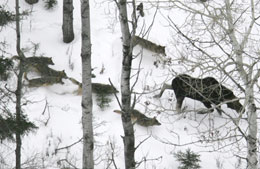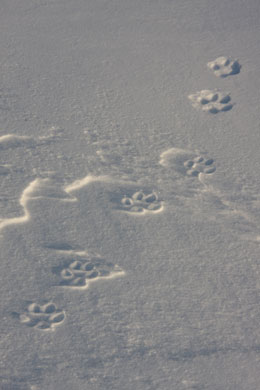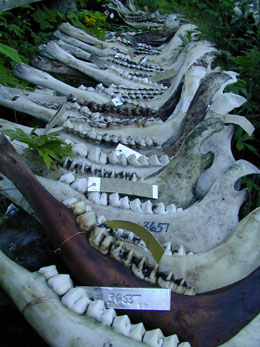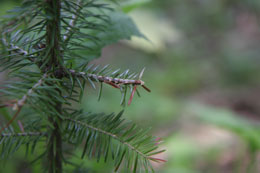Isle Royale is a remote wilderness island, isolated by the frigid waters of Lake Superior, and home to populations of wolves and moose. As predator and prey, their lives and deaths are linked in a drama that is timeless and historic. Their lives are historic because we have been documenting their lives for more than five decades. This research project is the longest continuous study of any predator-prey system in the world.
The purposes of this project are to better understand the ecology of predation and what that knowledge can teach us about our relationship with nature. Much of what we have learned is associated with having been patient enough to observe and study the fluctuations in wolf and moose abundances summarized above.
Isle Royale has offered many discoveries… how wolves affect populations of their prey, how population health is affected by inbreeding and genetics, what moose teeth can tell us about long-term trends in air pollution, how ravens give wolves a reason to live in packs, why wolves don’t always eat all the food that they kill, and more. The wolves and moose of Isle Royale also frequently reveal intimate details of their daily life experiences and they have inspired numerous artistic expressions. If we pay attention, they all tell us something important about our relationship with nature. These insights and discoveries are all presented here for you.
Building on the graph above and to develop a deeper understanding, here is more on the history of wolves and moose on Isle Royale. Moose first came to Isle Royale in the early 20th century, and for fifty years, their numbers fluctuated with weather conditions and food abundance. Wolves first arrived in the late 1940s by crossing an ice bridge from Canada. The lives of Isle Royale moose would never be the same.

Researchers began annual observations of wolves and moose on Isle Royale in 1958. The project began during the darkest hours for wolves in North America—humans had driven wolves to extinction in large portions of their former range. The hope had been that knowledge about wolves would replace hateful myths and form the basis for a wiser relationship with wolves.
Most studies in ecology last for a few years or less. Afterward, ecologists naturally draw conclusions about the nature of our environment. Scientists did so after observing the wolves and moose of Isle Royale for a few years . With wolf and moose abundances having not changed much, ecologists concluded that they seemed to exhibit some kind of “balance of nature” – an idea as elusive as it is compelling, and pursued by scientists and philosophers for millennia .
Durward Allen, who initiated the Isle Royale wolf-moose project in 1958, was a pioneer among ecologists for having the foresight to understand the value of continuing to observe where others would have drawn conclusions and moved on to study something different. He continued observing.
By 1969 the moose population had doubled, and one now had to admit there had been a major shift in the balance. The wolf-moose project was originally designed to continue for ten years. Administrators of the day suggested that the project end. Durward found greater merit in continuing to lead these observations.
By 1980, the study in its 22nd year, the moose population had tripled from its original size and then declined to half its maximum size. During that time, wolves more than doubled to fifty. By now it was apparent. Rich, dynamic variation, not ‘balance of nature’ seems to be the force that guides nature.
Rather than wondering how long scientists would keep observing Isle Royale’s wolves and moose, people began to ask thoughtful questions that could only be answered by continuing to observe. In particular, wolves in 1980 were abundant and moose had been on the decline for the better part of a decade. Would it be possible that wolves could drive their prey to extinction? No one knew. No one had ever observed wolves and their prey long enough to know.

The next two years were dramatic. Wolves plummeted from 50 to 14. Canine parvovirus, a disease inadvertently introduced by humans, was largely to blame for the decline . With only 14 wolves, extinction was a real concern. The only way to know what would happen next would be to continue observing .
The wolf population recovered partially during the mid-1980s, only to decline again. For much of a decade wolf abundance remained in the low teens. The low numbers of the early 1990s were difficult to explain because the disease was gone and the wolves’ food (moose) was abundant. It seemed plausible, but far from certain, that the low numbers were ultimately the negative consequences of inbreeding. All we knew for sure was that Isle Royale wolves are highly inbred and descended from just a single female and two males .
Low wolf abundance provided an unprecedented opportunity – a natural experiment of sorts – to see how moose would respond to reduced wolf predation. With predation low during the late 1980s and early 1990s, moose lived longer and gave birth to more calves. The moose population nearly tripled to almost 2,400 by 1996. During the winter of 1996, lack of forage for the moose, an outbreak of moose ticks , and severe winter all conspired against the moose. The winter had been more severe than any in over a century. The moose population collapsed from its all-time high to just 500 moose.

Just as the moose population collapsed, wolves seemed as though they would stage a comeback – their abundance doubled in the mid 1990s. With the collapse of the moose population, food for wolves was rare, and the timing of their comeback unfortunate.
What happened next is something we would not discover ourselves for another 14 years. During the winter of 1997, a wolf from Canada immigrated to Isle Royale. He crossed on an ice bridge that occasionally forms between Isle Royale and Canada. We knew him as “the Old Grey Guy.” He became one of the most successful wolves ever to live on Isle Royale, and he revitalized the population’s genetic diversity. His arrival also explains, in part, why wolves did pretty well from 1998 to 2004, during a time when it was relatively difficult for wolves to capture moose.
For several years around the turn of the century, moose seemed to be recovering. Then, a series of very hot summers struck. During hot summers moose feed less, as they spent more time resting in the shade. Having fed less, the undernourished moose were less prepared to survive the winters. Warm temperatures also enabled severe outbreaks of moose tick. Weakened by heat and ticks, moose dropped to their lowest observed levels. Wolves took advantage of weakened moose, fueling high rates of predation. During the first decade of the 21st century, the moose population steadily slid to its lowest levels.
The wolf population, with 30 individuals living in three packs, had been thriving until 2006. But with moose becoming increasingly rare, capturing food become increasingly difficult. One wolf pack failed after another. By 2011, the population was reduced to 9 wolves living in one pack and another half dozen wolves, the socially disorganized remnants of Middle Pack. DNA analysis of wolf scats collected at kill sites indicates no more than two adult females in the population. If they were to die before giving birth to new females, the wolves would be committed to extinction.
The wolves and moose of Isle Royale have been of interest for so long because they offer some very important, general lessons. Here is one of the most important.
Important attitudes about how we should relate to Nature, and some of our abusive relationships with Nature, are rooted in convictions that we understand Nature well, and can accurately predict how Nature will respond to our actions. For 50 years, the focused purpose of the Isle Royale wolf-moose project has been to predict and understand a relatively simple natural system.

But the more we studied, the more we came to realize how poor our previous explanations had been. The accuracy of our predictions for Isle Royale wolf and moose populations is comparable to those for long-term weather and financial markets. Every five-year period in the Isle Royale history has been different from every other five-year period – even after fifty years of close observation. The first 25 years of the chronology were fundamentally different from the second 25 years . And the next five decades will almost certainly be different from the first five decades. And the only way we will know how, is to continue observing. The most important events in the history of Isle Royale wolves and moose have been essentially unpredictable events – disease, tick outbreaks, severe winters, and immigrant wolves.
Don’t misunderstand – it’s not as though we’ve learned nothing. Much insight has been gained, for example, about wolves’ tendency to kill moose that are likely to die from other causes, the effect of climate and forest processes on animal populations, and even the role of ravens in shaping the distinctive social nature of wolves.
The lessons we learn seem to come more from explaining the past rather than predicting the future. For example, we didn’t predict the great population crash of wolves in the early 1980s or the moose crash in the mid 1990s. But afterward we were able to recognize circumstances that had lead to those and other events. Natural history might be much like human history – explainable, but not predictable.
Isle Royale illuminates one of the oldest questions in all ecology, “Is Nature best understood as the result of predictable law-like patterns that ecologists take as their task to discover?” Or, is Nature better understood as the result of innumerable contingencies, essentially a historical process that can be explained and understood but not very well predicted. Is Nature deterministic or contingent? Is ecological science like the study of physics or more like the study of human history? Does ecological knowledge basically boil down to natural history with lots of numbers and statistics?
With the wolves and moose of Isle Royale, where we are simultaneously and paradoxically impressed with how much and how little we understand. Voltaire was right, “The more we know the less certain we are.”
If we see Nature as a system whose future we can predict, then we will be confident in our efforts to control and manage Nature. If, in Nature, we are more impressed by its essentially contingent, and hence unpredictable character, then our relationship will be more strongly rooted in striving to live within the boundaries of Nature’s beautifully dynamic variation.
Western science has come to understand a great deal about Nature. But pride for our knowledge of Nature, need not become hubris to fuel an obsession with controlling Nature. The wolves and moose of Isle Royale show how it is not so difficult to be proud for all that we’ve learned about Nature, yet humble for knowing how limited our understanding of really is. This is the humility from which a rich relationship with Nature may be rooted.